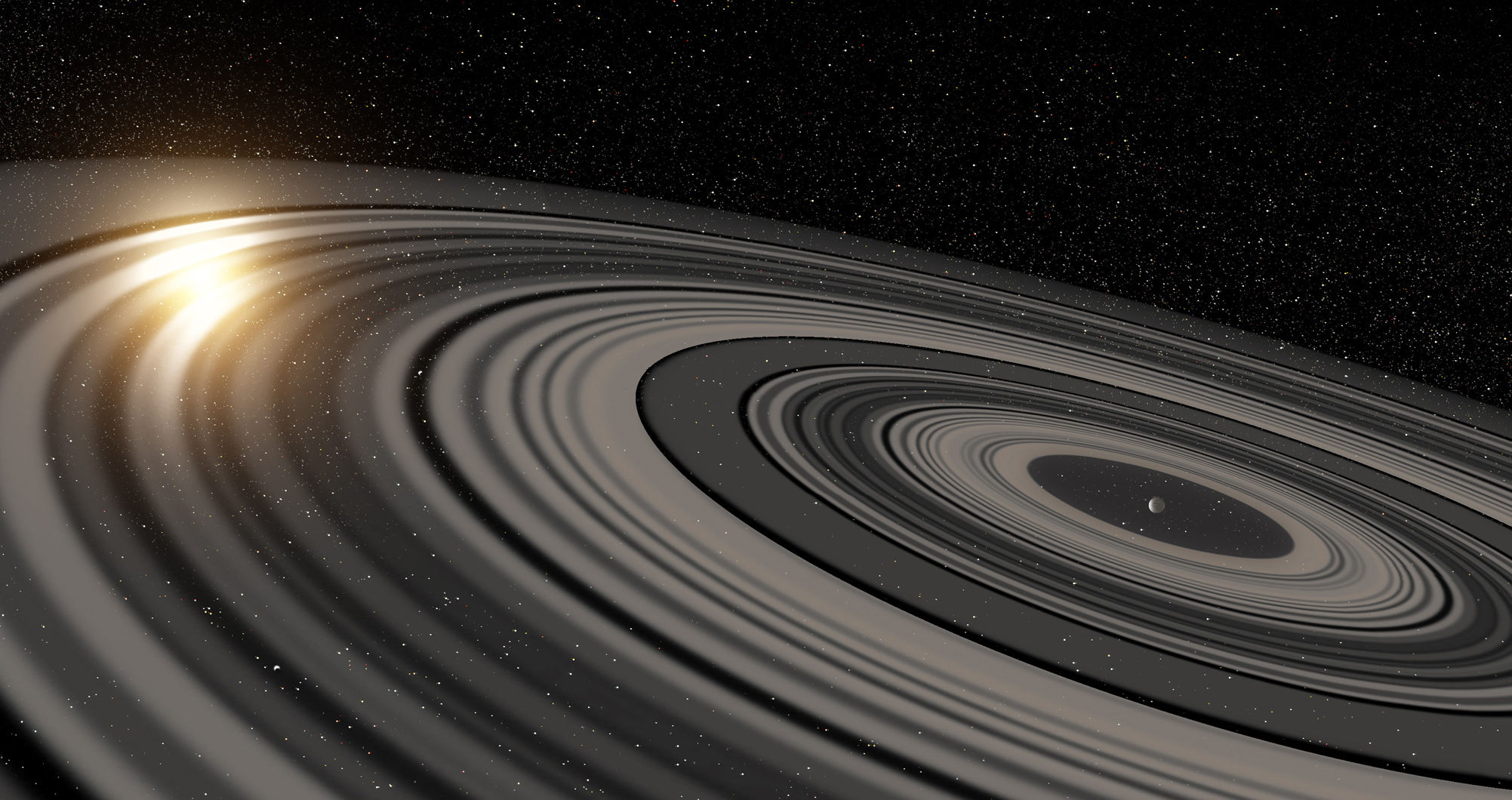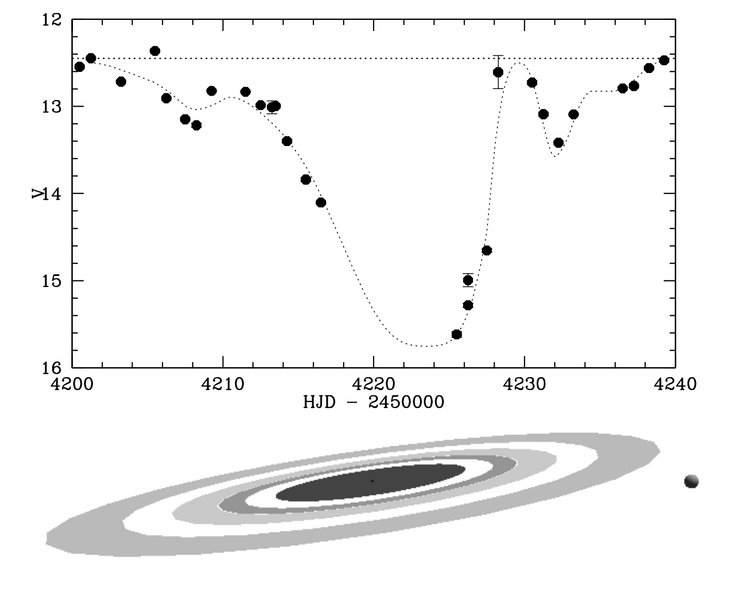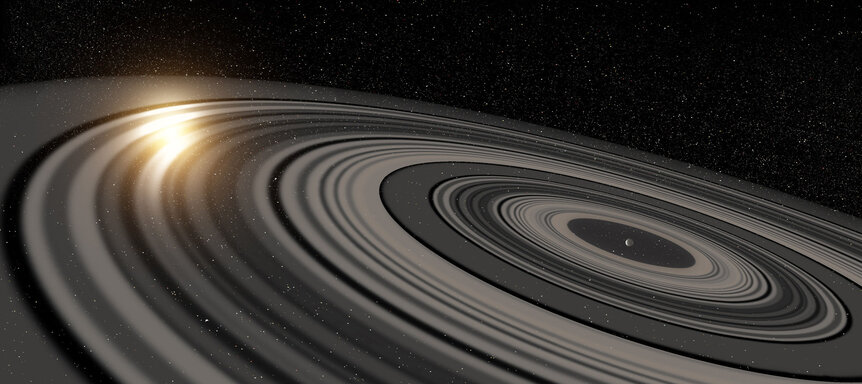Create a free profile to get unlimited access to exclusive videos, sweepstakes, and more!
Ring around the exoplanet?

In 2012, astronomers made a rather astonishing announcement: They had found an exoplanet (an alien world orbiting another star) that appeared to have a big ring system. And by big, I mean big: The rings (if they existed) were 180 million kilometers across, wider than the distance of the Earth from the Sun!
If you want to think of this as a superSaturn, bear in mind these rings would be 600 times the size of Saturn’s and 200,000 times more massive.
So, yeah. Wow. That’s a big ring.
The star is called 1SWASP J140747.93-394542.6, or just J1407 for short (the name is from the telescope system used to discover it, called SuperWASP, and its coordinates on the sky). In 2007, the star’s brightness made a complex series of dips, dropping at one point by as much as 95%, an incredibly deep decline.
This sounds like a transit, when a planet passes in front of its star as seen from Earth. That’s how most exoplanets are found, in fact. But usually the dips from transiting planets are around 1% in depth, not 95%! You’d need a huge object to do that, a planet as big as a star. Planets don’t get that big (they become stars long before that).
So what was doing this? It could be caused by any number of things (see Star, Tabby’s), but in this case something really extraordinary was seen: Out of all the dips, there were two pairs of dips that were symmetric before and after the main dip: 12 days before and after the main dip was one set of smaller dips, and another set 26 days before and after.
That’s what you expect for a set of rings orbiting the planet. Rings are big circles around the planet (probably seen at an angle, so they’d look like ellipses), so first there would be the leading edge of the rings passing in front of the star creating a series of dips, then once the planet passes you’d see the other side of the rings making dips in reverse order. The two sets of biggish dips really do sound like rings blocking the star.
Given the youthful age of the star (about 16 million years), what may be happening here is that we’re seeing a Jupiterish-mass planet — called J1407b — still in the process of forming. It’s surrounded by a huge disk of material it drew in from the original protoplanetary disk surrounding the star, and that is what’s causing the huge dip in star light: the inner part of that disk, choked with gas and dust, blocking the star. The series of dips could then be from gaps in the planet’s disk, perhaps carved out by moons forming inside it. One of the gaps is so large it may be caused by a moon that is comparable in size to Earth!
That’s incredibly exciting, if true. But is it true?
The big problem is that only one set of eclipses was seen, when the planet and alleged rings passed between us and the star. What we really need is to see it again, once the planet makes a complete orbit around the star. But how long does that take?
To answer that, a team of astronomers decided to dive into archival observations of J1407. They looked at images of that part of the sky taken by quite a few surveys over the years, including one done by Harvard University that has observations of J1407 as far back as 1890! Those were taken on glass plates, which had to be analyzed by hand. Whoa.
The astronomers compared the brightness of J1407 to three stars of about the same brightness that happen to be near it in the sky. Examining roughly 42,000 separate observations (!!), including nearly 30,000 from SuperWASP alone, they looked for any telltale dimming of J1407 compared to the three reference stars. And what they found was… nothing. Bupkis. Zip.
But that’s not so bad. Even though there have been lots of observations, they were taken at all different times of the year. Though the eclipses in total last for months, it’s possible that, through bad luck, the last few eclipses were simply missed. By looking at the spacing of the observations, they could narrow down what the potential period of the planet could be such that it was missed.
And they could do even more. For example, if the orbital period is short, that means the planet is close to the star. But remember, the ring system is huge. If the planet is too close to the star, the gravity from the star would tear the ring particles away from the planet. The planet has to be far enough from the star to allow such a large ring to exist, which puts a lower limit on the orbital period.
They could also use how rapidly the starlight dimmed to put an upper limit on the period as well. The speed of the planet is determined by its distance from the star, and that velocity determines how rapidly the dimming during eclipses occurs. Using reasonable assumption (including just how elliptical an orbit the planet can have), this can constrain how far from the star the planet is.
When all was said and done, they found that the most likely orbital period for the planet is either 16.5 or 17 years, with a likely range of 11–18 years. They can’t rule out a period longer than 22 years, though it seems unlikely. Also, given that the eclipse was seen in 2007, for an 11-year period the next eclipse would have been in spring 2018. No eclipse was seen, so it must have a longer period than that.
If it’s in the 17-year range, the next eclipse should be in 2024, but their numbers indicate it could be as early as 2021.
So, astronomers, here’s your chance. Hopefully there will be southern hemisphere telescopes observing J1407 pretty frequently to monitor it (the star is in Centaurus, a southern constellation not easily visible form the northern hemisphere). And if a dimming starts, I would love to see observations made as often as possible, even every few hours, for as long as possible. That would do so much! We’d be able to see how wide the wings are, and how many rings there are (one model suggest as many as 37 big enough to causes detectable dips). The period of the planet constrains the orbit, which gives us its distance from the star, which in turn gives us a lower limit to the planet’s mass (since it needs to be at least massive enough to hold on to the outermost ring particles). Right now the likely mass is between 5 – 20 times that of Jupiter, which is a pretty big range; it’d be nice to narrow that down. And the gaps in the rings can tell us about any potential exomoons as well!
At the very worst, more observations could disprove that there’s a ring system at all. Maybe the first observations were a fluke of some kind. That seems unlikely at this point, but even then it means there’s something else going on with J1407, something we don't yet understand, and that’s still pretty cool, too.
















